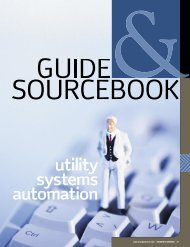FERC vs NERC: A grid control showdown over cyber security
FERC vs NERC: A grid control showdown over cyber security
FERC vs NERC: A grid control showdown over cyber security
Create successful ePaper yourself
Turn your PDF publications into a flip-book with our unique Google optimized e-Paper software.
WWW.INTELLIGENTUTILITY.COM /// JULY/AUGUST 2011<br />
26<br />
I asked about the cultural changes associated with adding<br />
new technologies to the mix in the field, and the types<br />
of technologies being incorporated with the field services<br />
groups at each utility.<br />
SCHACH It’s kind of interesting to watch. Like all utilities,<br />
and probably a lot of industry, we’ve got an aging workforce<br />
and we’re going through quite a transition with retirements<br />
and the like. What’s interesting, and it’s probably just a sign<br />
of the times, is that as we bring in these people to our organization<br />
who have had a little more access to the iPhones<br />
and the games and things that this generation is used to,<br />
not only are we not seeing a cultural issue, but we’re seeing,<br />
“Why can’t it do this?” or “Why can’t it do that?” The whole<br />
world is changing around us, and we’re actually getting in a<br />
generation of folks that not only find it easier to use, but also<br />
are helping us find ways to make it better.<br />
Now, having said that, we still have a considerable workforce<br />
that has been around for a long time and we spend a<br />
lot of time trying to ensure that we keep their training up to<br />
speed. We are providing a lot more communication about<br />
what the value is and trying to have them recall what they<br />
used to do compared with what they do today. What we’re<br />
seeing is that even those folks who at the beginning were just<br />
dead set against a laptop in the truck, I’d venture to stay that<br />
at least 80 percent are more than happy to have it and would<br />
be upset if you took it away.<br />
SCHEEL Historically, prior to 2007, we used some type of<br />
Toughbook. Sometimes, this is where you ask, okay, if you<br />
come from nothing, then you can introduce folks to anything<br />
new. We did try, and then when we went to make the<br />
change to what are we going to use in the future, we tried the<br />
PDAs. The folks did not like them: they said they were too<br />
small, they couldn’t see them.<br />
The field worker was<br />
provided the same<br />
level of functionality<br />
and capability that<br />
an office worker<br />
in our environment<br />
would have.<br />
MARK BROWNING<br />
UTILITY MOBILITY<br />
For me as management, I love the PDAs. But they did not<br />
like them. We even tried the tablets. I have to give kudos to<br />
our IT department. They said, okay, here’s what you have;<br />
take them and use them. But we voted on just a regular laptop.<br />
You can buy three laptops versus one Toughbook, and<br />
not all the trucks are so rough that they require a Toughbook.<br />
Now as far as field services, which is where I came from, I<br />
would strongly encourage the PDA if you can. But we have<br />
not engaged our employees enough. They are a little resistant<br />
to it, and right now, we’re not pushing that venue. We just<br />
use regular laptops with aircards that go into base mounts<br />
installed in the vehicle. But I would love to use PDAs. If it<br />
could start out that way, I would never give another option.<br />
BROWNING We started out thinking that we were going to<br />
deploy a lot of different form factors, a lot of different tools.<br />
Early on in the project, we quickly realized that the majority<br />
of users viewed the tool as something that was going to<br />
remain in their vehicle and that they wouldn’t be carrying it<br />
around. And it was really the taking it out of the vehicle and<br />
using it in various ways that we thought—in terms of collecting<br />
information in substations, making rounds and the<br />
like—would drive the need for different form factors.<br />
But we didn’t see that big push to drive to multiple form<br />
factors. So, we really took a one-size-fits-all approach for<br />
the project, and now, almost two years post-project, we’re<br />
starting to see maybe a revitalization of this drive for new<br />
form factors. I view it as a maturity and an evolution of the<br />
technology. The ruggedized laptop in the vehicle is probably<br />
something that solves 80 percent of our business problems,<br />
and now that 20 percent is driving the need to start to look<br />
at different form factors, in the form of smart phones and<br />
PDAs, that maybe synch with the device to go out, collect<br />
some form information and come back and sync with the<br />
vehicle’s MVT and push the information back up. So a lot of<br />
evolution, I think, is going to occur there <strong>over</strong> time.<br />
I asked each panelist about guiding principles or key lessons<br />
learned with their deployments. Here are a few of<br />
many that were discussed.<br />
BROWNING We approached this project as an extension of<br />
the edge of corporate network. This is an important piece in<br />
that we did not set any limitations or boundaries <strong>over</strong> what<br />
the field worker could do. The field worker was provided<br />
the same level of functionality and capability that an office<br />
worker in our environment would have. A fully enabled<br />
Web browser would allow them to leverage the corporate<br />
intranet and the Internet to perform their various work<br />
functions. And this was a key component that I think really<br />
helped our project gain traction with the field workers. It<br />
demonstrated trust in the field workers, trust that management<br />
had in their ability to use the tools, and it gave them<br />
an opportunity to look at how they could do their job in



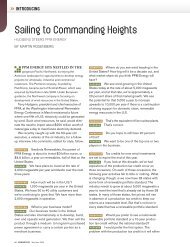
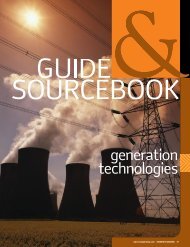
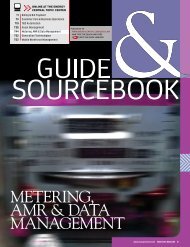

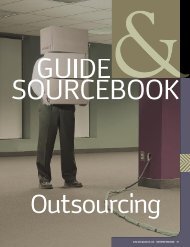
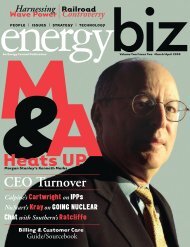

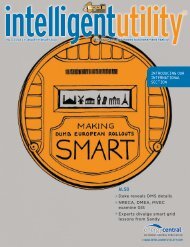
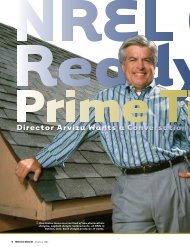
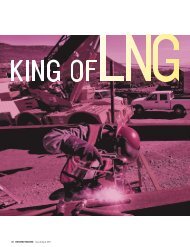


![View From the Trenches [PDF]](https://img.yumpu.com/18854438/1/190x252/view-from-the-trenches-pdf.jpg?quality=85)
